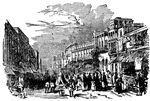Clipart tagged: ‘calcutta’

Jute
Jute, also known as Calcutta Hemp, is a fiber obtained from several species of the genus Corchorus of…

Carding Process in the Manufacuring of Jute
After the softening process in the manufacturing of jute, the fibers are about six feet long, and are…

Drawing Process in the Manufacturing of Jute
After the carding process in the manufacturing of jute is completed, the jute is taken into the drawing…
